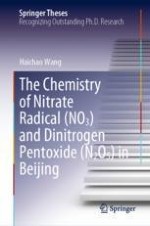2021 | Buch
Über dieses Buch
This book systematically describes the instrument setup for the measurement of nitrate radical (NO3) and dinitrogen pentoxide (N2O5), as well as the mixing ratio, chemical behaviors, and atmospheric impacts of NO3 and N2O5 in Beijing, China. It also discusses the instrument design and data analysis method in detail. Based on several field measurements of NO3 and N2O5 in Beijing, it shows the variation in concentration and the budget of NO3 and N2O5. The N2O5 heterogeneous uptake coefficient was determined using various methods, and the relationship between the N2O5 uptake coefficient and the particle properties was demonstrated, as well as the impact of NO3–N2O5 chemistry to the atmospheric oxidation and the formation of particulate nitrate. These results increase our understanding of nighttime chemistry and provide insights into the role of NO3–N2O5 chemistry in other polluted regions.
Anzeige
